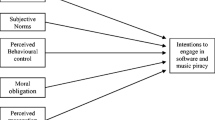Abstract
This study is a comparison of the validity of theory of reasoned action and theory of planned behavior as applied to the area of moral behavior (i.e., illegal copying of software) using structural equation modeling. Data were collected from 181 university students on the various components of the theories and used to asses the influence of attitude, subjective norm, and perceived behavioral control on the intention to make unauthorized software copies. Theory of planned behavior was found to be better than the theory of reasoned action in predicting unethical behavior. A modified version of the theory of planned behavior, with a causal path linking subjective norm to attitude, provided a significant improvement on model fit. The results indicated that perceived behavioral control is a better predictor of behavioral intention then attitude. The direct effect of subjective norm on behavioral intention was not significant, but the indirect effect through attitude was highly significant. Applicability of the theory of planned behavior for moral behavior and the implications for future research are discussed.
Similar content being viewed by others
References
Ajzen, I.: 1985, ‘From Intentions to Actions: A Theory of Planned Behavior’, in J. Kuhland and J. Beckman (eds.), Action-control: From Cognitions to Behavior (Springer, Heidelberg), pp. 11–39.
Ajzen, I.: 1991, ‘The Theory of Planned Behavior’, Organizational Behavior & Human Decision Processes 50, 179–211.
Ajzen, I. and M. Fishbein: 1980, Understanding Attitudes and Predicting Social Behavior (Prentice-Hall, Englewood Cliffs, New Jersey).
Ajzen, I. and T. J. Madden: 1986, ‘Prediction of Goal-Directed Behavior: Attitudes, Intentions, and Perceived Behavioral Control’, Journal of Experimental Social Psychology 22, 453–474.
Anderson, J. C. and D. W. Gerbing: 1988, ‘Structural Equation Modeling in Practice: A Review and Recommended Two-Step Approach’, Psychological Bulletin 103, 411–423.
Bentler, P. M.: 1990, ‘Comparative Fit Indexes in Structural Models’, Psychological Bulletin 107, 238–246.
Bentler, P. M.: 1992, ‘On the Fit of Models to Covariance and Methodology to the Bulletin’, Psychological Bulletin 112, 400–404.
Bentler, P. M.: 1993, EQS Structural Equations Program Manual (BMDP Statistical Software, Los Angeles).
Bollen, K. A.: 1989, Structural Equations with Latent Variables (Wiley, New York).
Bommer, M., C. Gratto, J. Gravander and M. Tuttle: 1987, ‘A Behavioral Model of Ethical and Unethical Decision Making’, Journal of Business Ethics 6, 265–280.
Brady, F. N. and M. J. Hatch: 1992, ‘General Causal Models in Business Ethics: An Essay on Colliding Research Traditions’, Journal of Business Ethics 11, 307–315.
Byrne, B. M.: 1994, Structural Equation Modeling with EQS and EQS/Windows: Basic Concepts, Applications, and Programming (SAGE, California).
Ferrel, O. C. and G. Gresham: 1985, ‘A Contingency Framework for Understanding Ethical Decision Making in Marketing’, Journal of Marketing 49, 87–96.
Fishbein, M. and I. Ajzen: 1975, Belief, Attitude, Intention, and Behavior: An Introduction to Theory and Research (Addison Wesley, Reading, Mass.).
Fredricks, A. J. and D. L. Dossett: 1983, ‘Attitude-Behavior Relations: A Comparison of the Fishbein-Ajzen and the Bentler-Speckart Models’, Journal of Personality and Social Psychology 45, 501–512.
Hunt, S. D. and S. Vitell: 1986, ‘A General Theory of Marketing Ethics’, Journal of Macromarketing 6, 5–16.
Madden, T. J., P. S. Ellen and I. Ajzen: 1992, ‘A Comparison of the Theory of Planned Behavior and the Theory of Reasoned Action’, Personality and Social Psychology Bulletin 18, 3–9.
Mathieson, K.: 1991, ‘Predicting User Intentions: Comparing the Technology Acceptance Model with the Theory of Planned Behavior’, Information Systems Research 2, 173–191.
Prestholdt, P. H., I. M. Lane and R. C. Mathews: 1987, ‘Nurse Turnover as Reasoned Action: Development of a Process Model’, Journal of Applied Psychology 72, 221–227.
Randall, D. M.: 1989, ‘Taking Stock: Can the Theory of Reasoned Action Explain Unethical Conduct?’, Journal of Business Ethics 8, 873–882.
Randall, D. M. and A. M. Gibson: 1991, ‘Ethical Decision Making in the Medical Profession: An Application of the Theory of Planned Behavior’, Journal of Business Ethics 10, 111–122.
Shepherd, G. J. and D. J. O'Keefe: 1984, ‘Separability of Attitudinal and Normative Influences on Behavioral Intentions in the Fishbein-Ajzen Model’, The Journal of Social Psychology 122, 287–288.
Sheppard, B. H., J. Hartwick and P. R. Warshaw: 1988, ‘The Theory of Reasoned Action: A Meta-Analysis of Past Research with Recommendations for Modifications and Future Research’, Journal of Consumer Research 15, 325–343.
Shimp, T. A. and A. Kavas: 1984, ‘The Theory of Reasoned Action Applied to Coupon Usage’, Journal of Consumer Research 11, 795–809.
Smiddy, J. D. and L. O. Smiddy: 1985, ‘Caught in the Act’, Datamation 31, 102–104.
Timko, C.: 1987, ‘Seeking Medical Care for a Breast Cancer Symptom: Determinants of Intentions to Engage in Prompt or Delay Behavior’, Health Psychology 6, 305–328.
Trevino, L. K.: 1986, ‘Ethical Decision Making in Organizations: A Person-Situation Interactionist Model’, Academy of Management Review 11, 601–617.
Vallerand, R. J., P. Deshaies, J. Cuerrier, L. G. Pelletier and C. Mongeau: 1992, ‘Ajzen and Fishbein's Theory of Reasoned Action as Applied to Moral Behavior: A Confirmatory Analysis’, Journal of Personality and Social Psychology 62, 98–109.
Young, H. M., L. Lierman, G. Powell-Cope, D. Kasprzyk and J. Q. Benoliel: 1991, ‘Operationalizing the Theory of Planned Behavior’, Research in Nursing & Health 14, 137–144.
Rights and permissions
About this article
Cite this article
Chang, M.K. Predicting Unethical Behavior: A Comparison of the Theory of Reasoned Action and the Theory of Planned Behavior. Journal of Business Ethics 17, 1825–1834 (1998). https://doi.org/10.1023/A:1005721401993
Issue Date:
DOI: https://doi.org/10.1023/A:1005721401993




